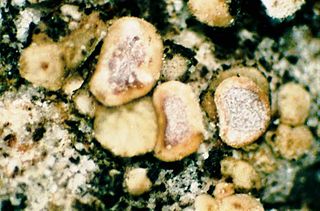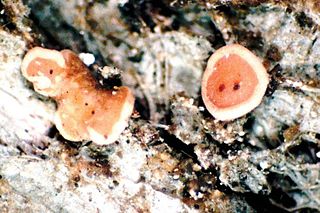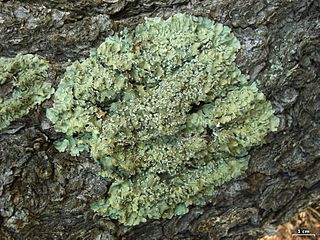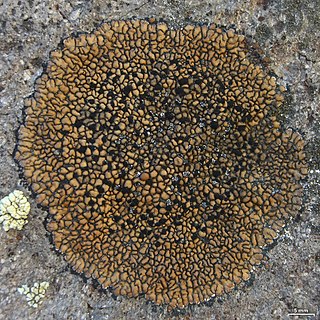
The Sphaerophoraceae are a family of lichenized fungi in the order Lecanorales. Species of this family have a widespread distribution, especially in southern temperate regions. Sphaerophoraceae was circumscribed by mycologist Elias Magnus Fries in 1831.

The Acarosporales are an order of fungi in the class Lecanoromycetes. Phylogenetic analyses conducted using the sequences of both the protein-coding gene RPB2 as well as nuclear ribosomal genes place this order within the subclass Acarosporomycetidae.

Coenogoniaceae is a family of fungi in the order Gyalectales. It consists of the single genus Coenogonium, which has an estimated 91 species.

The Gyalectaceae are a family of fungi in the order Gyalectales.
Lignoscripta is a genus of lichenized fungi in the family Trapeliaceae. This is a monotypic genus, containing the single species Lignoscripta atroalba.
Coppinsia is a genus of lichenized fungi in the family Trapeliaceae. This is a monotypic genus, containing the single species Coppinsia minutissima.
Anomalographis is a genus of two species of lichenized fungi in the family Graphidaceae.
Squamella is a genus of lichenized fungi in the family Cladoniaceae. A monotypic genus, Squamella contains the single species Squamella spumosa found in Australia. Both the genus and species were described by Samuel Hammer in 2001.
Trichothelium is a genus of lichenized fungi in the family Trichotheliaceae. It has an estimated 40 species. The genus was circumscribed by Swiss lichenologist Johannes Müller Argoviensis in 1885.

Anaptychia is a genus of lichenized fungi in the family Physciaceae.

Diploicia is a genus of lichenized fungi in the family Caliciaceae. The genus has a widespread distribution, especially in temperate regions, and contains 6 species.

Flavopunctelia is a genus of foliose lichens fungi in the family Parmeliaceae. The genus contains five species that are widespread in temperate and tropical areas.
Semigyalecta is a genus of fungi in the family Gyalectaceae. It is a monotypic genus, containing the single species Semigyalecta paradoxa, described as new to science in 1921 by Finnish lichenologist Edvard August Vainio.
Cryptodiscus is a genus of fungi in the family Stictidaceae. It contains 9 species.
Homothecium is a genus of lichen-forming fungi in the family Pannariaceae.

The Ophioparmaceae are a small family of lichen-forming fungi in the order Umbilicariales. The family was circumscribed in 1988 by lichenologists Roderick Westgarth Rogers and H. Thorsten Lumbsch.
Neophyllis a genus of lichenized fungi in the order Lecanorales. The genus contains two species found in Australasia. Originally classified in the family Cladoniaceae, the genus was transferred to the Sphaerophoraceae in 1999.

The Lecideales are an order of lichenized fungi in the class Lecanoromycetes. The order contains two families: the Lecideaceae, which contains 29 genera and about 260 species, and Lopadiaceae, which contains the single genus Lopadium of 10 species.

Ovicuculispora is a genus of lichenicolous fungi in the family Bionectriaceae. The genus was circumscribed by Javier Etayo in 2010, with O. parmeliae assigned as the type species. This species had formerly been placed in the genera Nectria in 1981, and later (2001) in Nectriopsis.
Lichtheimiaceae is a family of fungi in the order Mucorales. The family was circumscribed in 2013 after a molecular phylogenetic analysis helped delineate a new family structure for the Mucorales.









